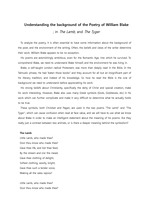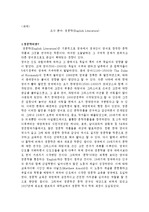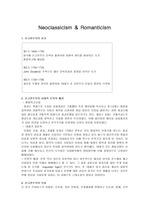

BRONZE
BRONZE 등급의 판매자 자료
william blake의 시의 배경에 대한 영문 에세이
william blake의 시의 배경에 대한 영문 에세이입니다.
5 페이지
최초등록일 2009.08.17
최종저작일
2009.08

-
미리보기
소개
william blake의 시의 배경에 대한 영문 에세이입니다.목차
없음본문내용
To analyze the poetry, it is often essential to have some information about the background of the poet, and the environment of the writing. Often, the beliefs and views of the writer determine their work. William Blake appears to be no exception.
His poems are astonishingly ambitious, even for the Romantic Age, into which he survived. To comprehend Blake, we need to understand Blake himself, and the environment he was living in.
Blake, a self-taught London radical Protestant, was more than deeply read in the Bible. In the Talmudic phrase, He had “eaten those books” and they account for all but an insignificant part of his literary tradition, and indeed of his knowledge. So how he read the Bible is the one of background we need to understand before appreciating his work.
His strong beliefs about Christianity, specifically the deity of Christ and special creation, make his work interesting. However, Blake also uses many Greek symbols (Gods, Goddesses, etc) in his work which can further complicate and make it very difficult to determine what he actually holds to be true.
These symbols, both Christian and Pagan, are used in the two poems "The Lamb" and "The Tyger", which can cause confusion when read at face value, and we will have to use what we know about Blake in order to make an intelligent statement about the meaning of his poems. Are they really just a contrast between two animals, or is there a deeper meaning behind the symbolism?참고자료
· 없음태그
-
자료후기
-
자주묻는질문의 답변을 확인해 주세요

꼭 알아주세요
-
자료의 정보 및 내용의 진실성에 대하여 해피캠퍼스는 보증하지 않으며, 해당 정보 및 게시물 저작권과 기타 법적 책임은 자료 등록자에게 있습니다.
자료 및 게시물 내용의 불법적 이용, 무단 전재∙배포는 금지되어 있습니다.
저작권침해, 명예훼손 등 분쟁 요소 발견 시 고객센터의 저작권침해 신고센터를 이용해 주시기 바랍니다. -
해피캠퍼스는 구매자와 판매자 모두가 만족하는 서비스가 되도록 노력하고 있으며, 아래의 4가지 자료환불 조건을 꼭 확인해주시기 바랍니다.
파일오류 중복자료 저작권 없음 설명과 실제 내용 불일치 파일의 다운로드가 제대로 되지 않거나 파일형식에 맞는 프로그램으로 정상 작동하지 않는 경우 다른 자료와 70% 이상 내용이 일치하는 경우 (중복임을 확인할 수 있는 근거 필요함) 인터넷의 다른 사이트, 연구기관, 학교, 서적 등의 자료를 도용한 경우 자료의 설명과 실제 자료의 내용이 일치하지 않는 경우
함께 구매한 자료도 확인해 보세요!
-
한밭대학교리포트앞표지 1페이지
-
[영미시] William Blake 의 The Tiger ( 와 fire의 연관성 ) 4페이지
About "Fire" of "the Tiger" The Tiger has ambiguity in content. and this poem of idea has been controversial for many people. William Blake wrote this poem. William Blake published "the Lamb" in ad.. -
와플&커피 전문 스넥카 창업계획서입니다. 16페이지
사업 개요(1) 우리는 먼저 제품의 차별성에 중점을 두고 이 사업을 계획하였다. 그 이유는 고객들이 찾는 기존의 와플들은 어디서든지 찾기가 쉽기 때문이었다. 그래서 우리는 우리만의 와플을 만들기로 결정했다. 와플에 녹차, 초코, 딸기가루 등을 첨가하여 시럽을 안바르고 단순히 와플만 먹어도 맛이 있고 와플의 색이 다양함으로써 눈의 즐거움을 더하였다. .. -
‘The Lamb’와 ‘The Tyger’ 대조/William Blake 2페이지
‘The Lamb’과 ‘The Tyger’ 대조 Blake는 선악과를 먹기 이전의 상태를 인간영혼의 영원한 “the State of Innocence"로 상징하고, 선악과를 먹고 타락된 이후의 상태를 인간영혼의 ”the State of Experience"로 상징하였는데 이것이 곧 「Songs of Innocence」와 「Songs of Expe.. -
[영미시] William Blake의 시집 Songs of Experience 해석과 분석 11페이지
1. Introduction Hear the voice of the Bard! Who Present, Past, & Future, sees; Whose ears have heard The Holy Word That walk`d among the ancient trees; Calling the lapsed SoulAnd weeping in the ev..
찾으시던 자료가 아닌가요?
지금 보는 자료와 연관되어 있어요!
문서 초안을 생성해주는 EasyAI




